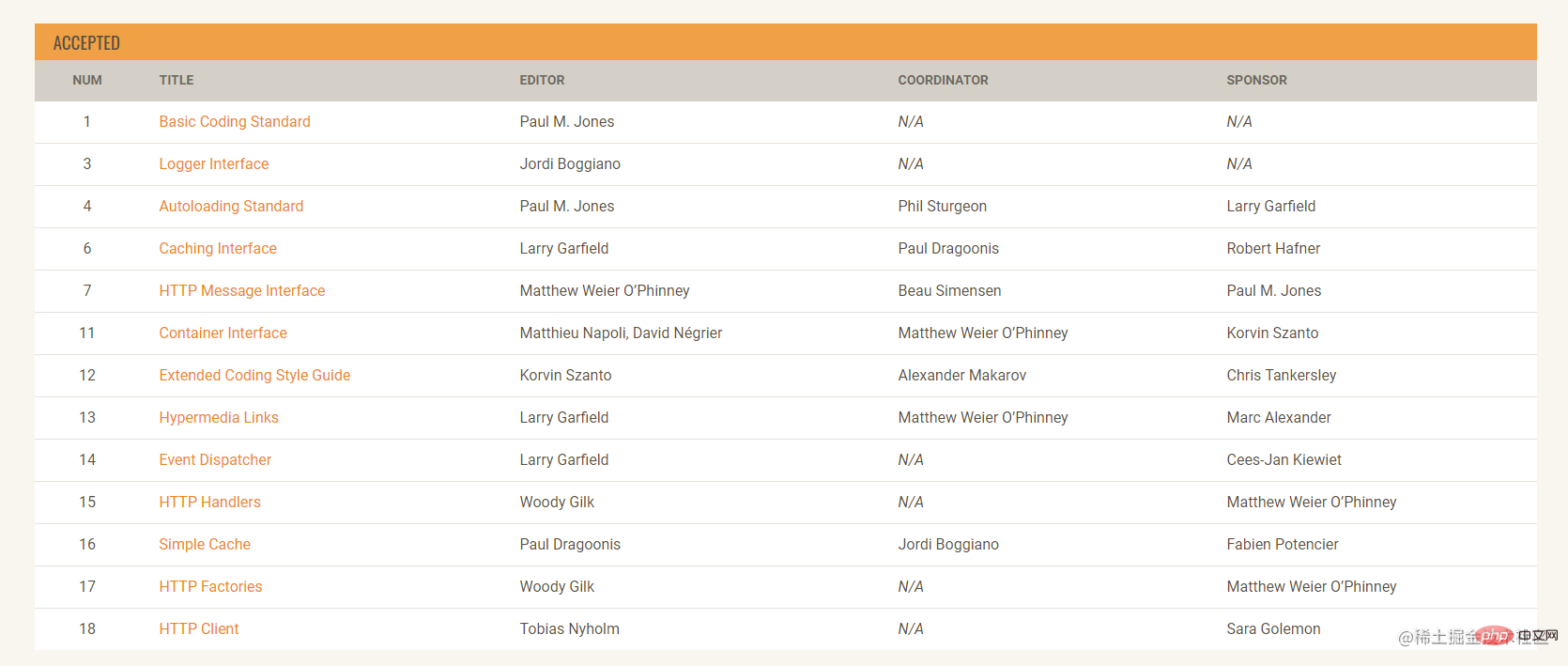
This article brings you relevant knowledge about PHP. It mainly talks about coding standards with you. It is also recommended that you try to follow the standards during development. Interested friends can take a look at it together. I hope it will be helpful to you. Everyone is helpful.
I hope it can help you quickly build a framework of your own, which can bring some benefits to your work or study. Come for some help and inspiration.
PSR specification
Usage of composer
Quickly build an API interface framework
Redis applications of various data types
Cache application analysis
Before developing the framework, let me introduce the specifications followed by the framework development.
Most programming languages have their own set of coding standards. As the "best language in the world", PHP certainly has its own coding standards. This specification is PHP Standard Recommendation (PSR for short).
Of course, from my own work, I found that many PHP programmers, especially junior programmers, do not know that PHP has such a specification. I think this is unscientific.
What is PSR?
Before introducing PSR, we need to introduce the organization that formulated this specification-----PHP-FIG, whose full name is PHP Framework Interoperability.
Organization members formulate specifications and implement them in their own projects. Although it is not an official organization, it also represents most PHP community projects, such as CakePHP, Composer, Drupal, PEAR, Slim, Yii framework, Zend Framework wait. And more and more projects are joining and following this standard.
The purpose of the PSR project is to develop a collaboration standard with the lowest level of restrictions through discussions between framework authors or representatives of the framework. Each framework follows unified coding standards to allow engineers to work together better.
Up to now, 20 items have been listed on the official website. Excluding those in drafting and discarded, there are the following 13 items.

Let’s take a look at these specifications:
PSR-1 Basic Coding Specification
PSR-12 code style specifications
PSR-12 specifications are very detailed. Contains descriptions of declarations, namespaces, classes and inheritance, and control structures.
Let’s take a look at a demo first:
<?php
declare(strict_types=1);
namespace Vendor\Package;
use Vendor\Package\{ClassA as A, ClassB, ClassC as C};
use Vendor\Package\SomeNamespace\ClassD as D;
use function Vendor\Package\{functionA, functionB, functionC};
use const Vendor\Package\{ConstantA, ConstantB, ConstantC};
class Foo extends Bar implements FooInterface
{
public function sampleFunction(int $a, int $b = null): array
{
if ($a === $b) {
bar();
} elseif ($a > $b) {
$foo->bar($arg1);
} else {
BazClass::bar($arg2, $arg3);
}
}
final public static function bar()
{
// method body
}
}控制结构关键词后必须有一个空格。
左括号 ( 后一定不能有空格。
右括号 ) 前也一定不能有空格。
右括号 ) 与开始花括号 { 间一定有一个空格。
结构体主体一定要有一次缩进。
结束花括号 } 一定在结构体主体后单独成行。复制代码There are many code style specifications, so I won’t explain them one by one here. You can read them by yourself
PSR-4 Autoloading
Regarding the relevant specifications for automatically loading corresponding classes from file paths, this specification is interoperable and can be used as a supplement to any automatic loading specification, including PSR- 0. In addition, this PSR also includes the file storage path specification corresponding to the automatically loaded class.
The "class" here refers to all classes, interfaces, traits reusable code blocks and other similar structures.
A complete class name must have the following structure:
\<命名空间>(\<子命名空间>)*\<类名>
The complete class namemusthave a top-level Namespace, called "vendor namespace";
The complete class namecanhave one or more sub-namespaces;
The complete class namemusthave a final class name;
Underscores in any part of the complete class name have no special meaning ;
The complete class namecanbe composed of any uppercase and lowercase letters;
must Is case sensitive.
immediately following the namespace prefix must match the corresponding "file base directory", and the namespace separator in it will be used as the directory separator. The class name at the end of
must have the same name as the corresponding file with the suffix .php.
must not throw an exception, must not trigger any level of error message and Should have a return value.
| Namespace prefix | File base directory | File path | |
|---|---|---|---|
| Acme\Log\Writer | ./acme-log-writer/lib/ | ./acme-log-writer/lib/File_Writer.php | |
| Aura\Web | /path/to/aura-web/src/ | /path/to/aura-web/src/Response/Status.php | |
| Symfony\Core | ./vendor/Symfony/Core/ | ./vendor/Symfony/Core/Request.php | |
| Zend | /usr/includes/Zend/ | /usr/includes/Zend/Acl.php |
Click to view more latest specification suggestions
PHP Video Tutorial"
The above is the detailed content of Handwritten PHP API Framework (1) PSR Specification. For more information, please follow other related articles on the PHP Chinese website!